Recent Water Damage Posts
Water Damage Indicators
5/6/2024 (Permalink)
 Water damaged ceiling tile
Water damaged ceiling tile
Here are some of the most common indicators of water damage:
Water Accumulation
One of the most visible signs of water damage, water accumulation can come from malfunctioning appliances such as dishwashers, water heaters, faucets, and toilets. Pooling water is a form of water accumulation that can be easy to spot, typically a result of a leaking roof or faulty drainage pipes.
Discoloration
Water can cause great aesthetic damage to your home if left unchecked. It can stain walls and carpets, as well as rust your home’s pipes and water heater. By keeping a close watch on any leakage problems, you can prevent your nice home from becoming a brown musty mess.
Changes in Texture
When water seeps into the floorboards of tiles and areas underneath them, it can alter their texture. For example, wood and laminated floors expand when they absorb a lot of water, unsticking them from the base. Although this kind of damage is easy to spot, it may be difficult to identify the source of the damage.
Odor
One of the telltale signs of water damage is odor. If you consistently find yourself smelling mold, mildew, and other muggy scents then you probably have a water damage problem. Certain drywall materials, such as tape and frames, act like a sponge and attract and absorb moisture. These are the perfect conditions for mold to develop, which leads to those pesky odors.
Frozen Pipe Prevention
1/2/2024 (Permalink)
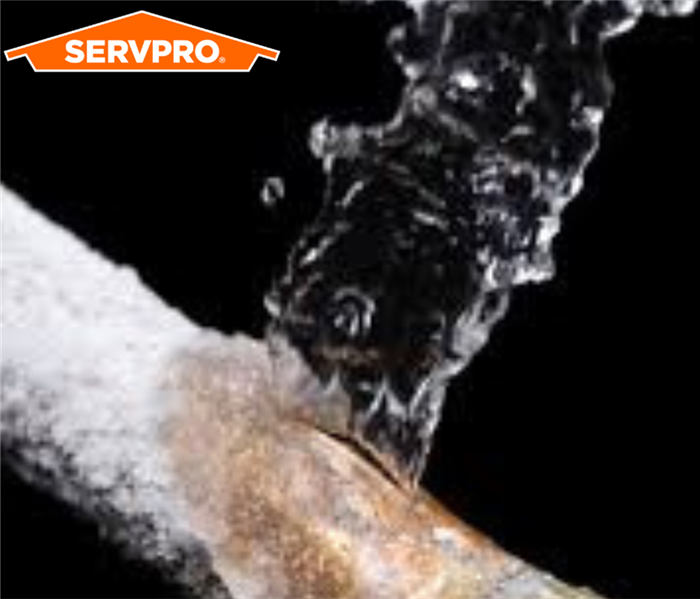 Frozen Pipe
Frozen Pipe
One of the most common reasons why water pipes burst is due to freezing. When the temperature drops, the water inside the pipes can freeze, expand, and cause the pipes to burst. To prevent this from happening, there are a few steps you can take:
- Insulation. Insulating exposed pipes with insulation wraps or foam sleeves is a common and useful way to prevent pipes from freezing.
Seal air leaks. Sealing air leaks around windows, doors, and ventilation fans can prevent cold air from reaching the pipes.
Let faucets drip. Running water through pipes helps to prevent them from freezing, so be sure to let faucets drip slightly during cold weather.
Sewer Backup!!!
3/2/2023 (Permalink)
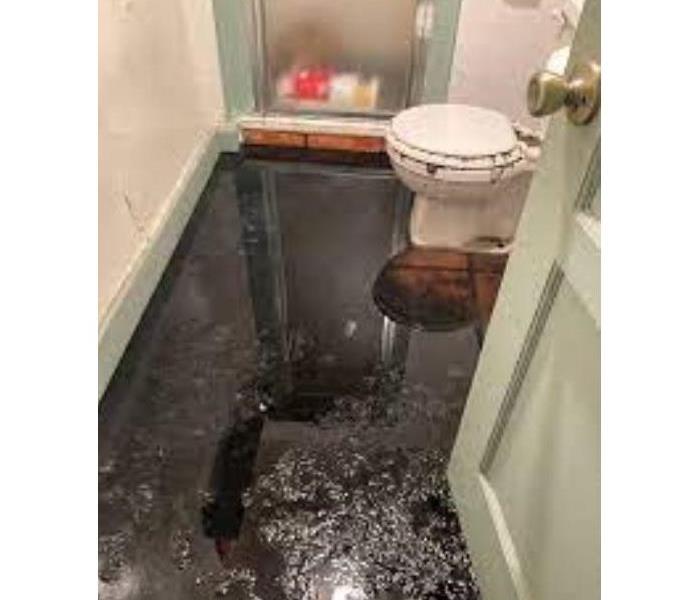 Toilet overflow
Toilet overflow
Sewer backups should be considered an emergency since the water may contain viruses, bacteria, and other microbes that cause serious illnesses. SERVPRO has the specialized training and equipment to quickly and safely clean contaminants like sewage.
Water damage can be classified by the three types of contaminated water. SERVPRO will inspect your home or business to determine the appropriate plan of action for the type of water encountered.
The three types of contaminated water:
Category 1:
Category 1 water is from a clean source like a broken water supply line or leaking faucet. If not treated quickly, this water can turn into category 2 or 3, depending on length of time, temperature, and contact with surrounding contaminants.
- Water from a clean source like a broken water line
- If left untreated, can degrade into category 2 or 3
Category 2:
Category 2 water is contaminated and could cause discomfort or illness. Examples include washing machine overflow; toilet overflow with some urine, but no feces; or dishwasher overflow.
- May contain bacteria and viruses
- Can quickly degrade into category 3 if left untreated
Category 3:
Category 3 water is grossly contaminated and could cause severe illness or death if ingested and any contact should be avoided. Examples include flooding from rivers or streams, water from beyond the toilet trap, water from the toilet bowl with feces, or standing water that has begun to support microbial growth.
- May contain untreated sewage, harsh chemicals, and microbes
- Water from flooding rivers or sewer backup
24-Hour Emergency Service
Water contaminated with sewage backup should be considered an emergency situation and dealt with as quickly as possible. SERVPRO of Mayes & Wagoner Counties is available 24 hours a day, 365 days a year. They are water damage restoration specialists with specialized training, equipment and protective gear to safely restore your home or business.
Ideas on how to prevent pipes from freezing
11/7/2022 (Permalink)
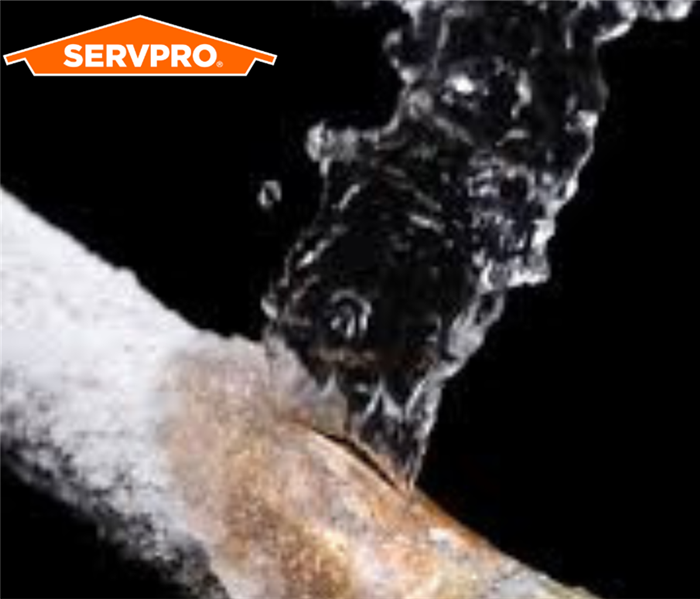 Freezing and Bursting Pipes Due to Cold Temperatures
Freezing and Bursting Pipes Due to Cold Temperatures
Frozen pipes could be a big problem and can be prevented.
In addition to conducting regular winter home maintenance, protecting pipes from freezing is important. Even a tiny crack in a pipe can spew hundreds of gallons of water causing flooding, damage to your furnace and serious structural damage. It also presents an immediate potential for mold.
Frozen water pipes are a problem in both cold and warmer climates, affecting families each winter. It can occur in homes with both plastic and copper pipes. By taking the preventative measures below, you may help reduce the risk of frozen water pipes and the resulting property damage.
Tips to help prevent pipes from freezing
The three central causes of frozen pipes are quick drops in temperature, poor insulation and thermostats set too low. You can prepare your home during the warmer months.
- Insulate pipes. Pipe insulation in your home's crawl spaces and attic helps even if you live in a climate where freezing is uncommon. Exposed pipes are most susceptible to freezing. Remember, the more insulation you use, the better protected your pipes will be.
- Use heat tape or heat cables. Heat tape or thermostatically controlled heat cables can be used to wrap pipes. Be sure to use products approved by an independent testing organization, such as Underwriters Laboratories Inc., and only for the use intended (exterior or interior). Closely follow all manufacturer's installation and operation instructions.
- Seal leaks. Locate and thoroughly seal leaks that allow cold air inside. Look for air leaks around electrical wiring, dryer vents and pipes, and use caulk or insulation to keep the cold out.
- Secure outdoor hoses, valves and faucets. Before winter hits, disconnect garden hoses and, if possible, use an indoor valve to shut off and drain water from pipes leading to outside faucets. This reduces the chance of freezing in the short span of pipe just inside the house.
- Let water drip. A trickle of hot and cold water might be all it takes to keep your pipes from freezing. Let warm water drip overnight when temperatures are cold, preferably from a faucet on an outside wall.
- Adjust the thermostat. Keeping your thermostat set at the same temperature during both day and night also reduces the risk of frozen pipes. During extreme cold, this also helps reduce the strain on the furnace.
- Open cabinet doors. This allows heat to get to un-insulated pipes under sinks and appliances near exterior walls.
5 Signs of Moisture Damage in Your Home
11/1/2022 (Permalink)
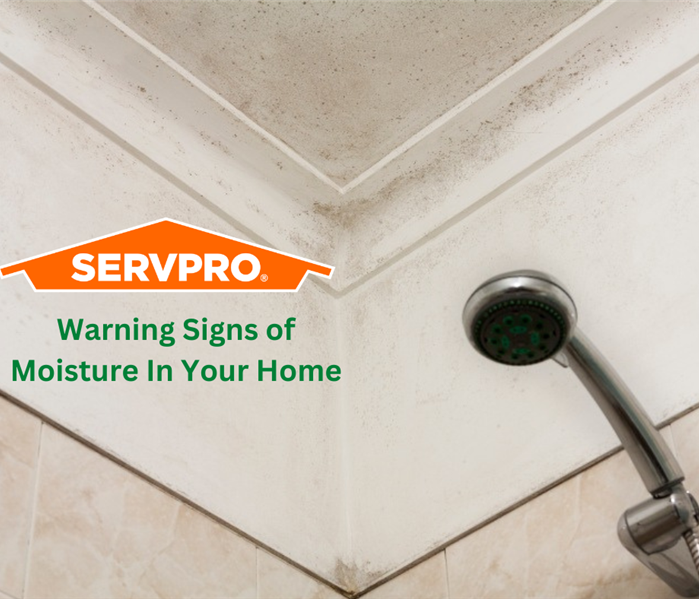 The professionals at SERVPRO are always available for a moisture damage estimate!
The professionals at SERVPRO are always available for a moisture damage estimate!
Throughout the years of providing water damage restoration services, we have found that moisture damage is common in many Atlanta homes without homeowners' awareness. Moisture damage can cause many problems in a home, including permanent structural damage. Therefore, identifying the five most common signs of moisture damage early on is essential to protect your home and prevent future issues.
The five common signs of moisture damage are:
- Water stains or discoloration on walls, ceilings, or floors
- Peeling paint or wallpaper
- Growth of mold or mildew
- Warping or buckling of floors, walls, or ceilings
- Bug infestation If you have any questions or want immediate water damage assistance, get in touch with SERVPRO of Mayes and Wagoner Counties. We are always here to help!
What is moisture damage?
Moisture damage is any water-related damage that can occur in your home, including damage caused by a leaky roof, a broken pipe, or flooding. If left untreated, moisture damage can cause permanent structural damage to your home and other significant problems.
The five most common signs of moisture damage
Now that you are familiar with what moisture damage is, let's take a closer look at the five most common signs that moisture damage has occurred in your home.
1) Water stains or discoloration on walls, ceilings, or floors
One of the most common signs of moisture damage is water stains or discoloration on walls, ceilings, or floors. If you notice any water stains in your home, it's crucial to investigate the cause and take steps to fix the issue. In addition, leaks usually cause water stains, so it's essential to find and repair the source of the leak as soon as possible.
2) Peeling paint or wallpaper
Another common sign of moisture damage is peeling paint or wallpaper. If you notice that the paint or wallpaper in your home is peeling, it's a good idea to check for moisture damage. Peeling paint or wallpaper can be caused by high humidity levels, so it's crucial to ensure that your home is well-ventilated.
3) Mold or mildew growth
Mold and mildew growth is another common sign of moisture damage. If you notice mold or mildew in your home, it's essential to take steps to remove it and prevent it from coming back. Mold and mildew can cause serious problems, so ensuring your home is clean and moisture-free is essential.
4) Warping or buckling of floors, walls, or ceilings
Warping or buckling floors, walls, or ceilings are another common sign of moisture damage. If you notice any warping or buckling in your home, it's crucial to investigate the cause and take steps to fix the issue.
5) Bug infestation
A common sign of moisture damage is a bug infestation. If you notice bugs in your home, it's essential to take steps to remove them and prevent them from coming back. Bugs are attracted to moisture, so it's vital to ensure that your home is clean and free of moisture.
Preventing moisture damage
As you can see, moisture damage can cause many problems in your home. Keeping your home dry and well-ventilated is essential to prevent moisture damage. Some tips for preventing moisture damage include:
- Fixing any leaks in your home as soon as possible.
- Checking for moisture regularly and taking steps to dry wet areas.
- Ventilating your home to reduce moisture buildup.
- Using a dehumidifier to control humidity levels.
- Keep gutters clean and free of debris.
The professionals at SERVPRO of Mayes and Wagoner Counties can help combat moisture damage
We covered a lot of information on moisture damage, including the common signs that moisture damage has occurred in your home. Those common signs are:
- Water stains or discoloration on walls, ceilings, or floors
- Peeling paint or wallpaper
- Growth of mold or mildew
- Warping or buckling of floors, walls, or ceilings
- Bug infestation
We also discussed ways to prevent moisture damage in your home because prevention is the number one best way to keep moisture damage from happening. However, if moisture damage occurs in your home, don't hesitate to contact SERVPRO of Mayes and Wagoner Counties.
SERVPRO of Mayes and Wagoner Counties is an IICRC accredited firm, and our team of professionals has the training and experience necessary to help you combat moisture damage. We are available 24/7, 365 days a year, so don't hesitate to contact us.
Water Damage Comes in all Types
4/15/2021 (Permalink)
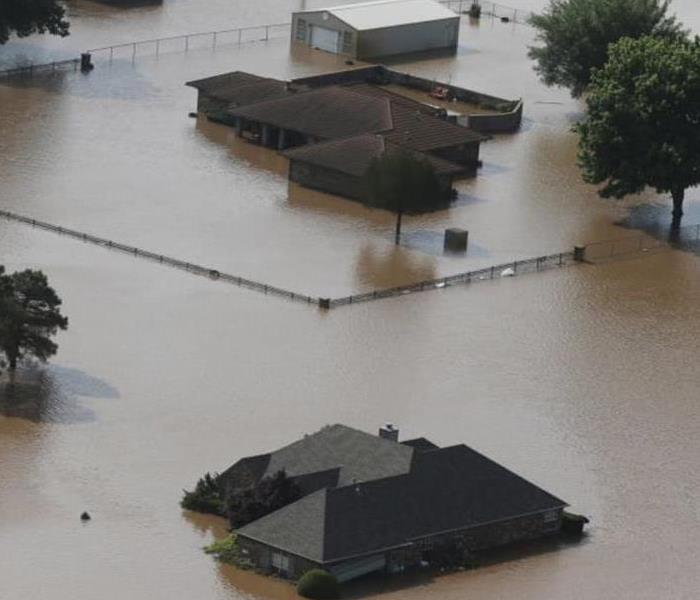 Flood waters from the May 2019 Historical Oklahoma Flood
Flood waters from the May 2019 Historical Oklahoma Flood
Water damage is two words that every home or business owner dreads hearing.
Water damage can originate by different sources such as a broken dishwasher hose, a washing machine overflow, a dishwasher leakage, broken/leaking pipes, flood waters, groundwater seepage, building envelope failures (leaking roof, windows, doors, siding, etc.) and clogged toilets.
According to the Environmental Protection Agency (EPA), 13.7% of all water used in the home today can be attributed to plumbing leaks.
Water damage begins when intruding water, it will enable attack of a material or system by destructive processes such as rotting of wood, mold growth, bacteria growth, rusting of steel, swelling of composite woods, de-laminating of materials such as plywood, etc.
The damage may be imperceptibly slow and minor such as water spots that could eventually mar a surface, or it may be instantaneous and catastrophic such as burst pipes and flooding. However fast it occurs, water damage is a major contributor to loss of property.
Between May and June 2019, the Green County area saw historic widespread flooding along the Arkansas River basin and its tributaries, which includes the Grand and Verdigris Rivers. The flooding reached from Fort Gibson Lake area to the Grand Lake area. Towns affected in our territory were Locust Grove, Chouteau, Wagoner, Coweta, Salina, Spavinaw, Kansas, Rose, Langley, Adiar, Inola, Claremore, Pensacola and Disney.
Flooding in the Arkansas River basin caused an estimated $3 billion in damage and killed five people.
There are three basic categories of water damage, based on the level of contamination.
Category 1 Water - Refers to a source of water that does not pose substantial threat to humans and classified as "clean water". Examples are broken water supply lines, tub or sink overflows or appliance malfunctions that involves water supply lines.
Category 2 Water - Refers to a source of water that contains a significant degree of chemical, biological or physical contaminants and causes discomfort or sickness when consumed or even exposed to. Known as "grey water". This type carries microorganisms and nutrients of micro-organisms. Examples are toilet bowls with urine (no feces), sump pump failures, seepage due to hydrostatic failure and water discharge from dishwashers or washing machines.
Category 3 Water - Known as "black water" and is grossly unsanitary. This water contains unsanitary agents, harmful bacteria and fungi, causing severe discomfort or sickness. Type 3 category are contaminated water sources that affect the indoor environment. This category includes water sources from sewage, seawater, rising water from rivers or streams, storm surge, ground surface water or standing water.
Category 2 Water or Grey Water that is not promptly removed from the structure and or have remained stagnant may be re classified as Category 3 Water. Toilet back flows that originates from beyond the toilet trap is considered black water contamination regardless of visible content or color.
Remember that every water damage is different, each requiring a unique solution. Your SERVPRO® of Mayes and Wagoner Counties team will inspect the damage to your property, then access what steps need to be taken, then create a plan of action.
Remember that SERVPRO® works will all insurance companies and is the preferred vendor for most insurance companies.
As a business or homeowner, one of the most important parts of the process is determining where the water has come from.. Finding the cause and making sure that the leak is fixed is the first of many steps that need to be taken.
The Damage - If left unresolved water damage can cost the home or business owner thousands of dollars’ worth of damage.
The Recovery - It is important to get our SERVPRO® team to the water loss as soon as possible to get the water removed swiftly.
- Our technicians use specialized equipment to target the water and use moisture sensing equipment to detect any wetness hiding where we cannot see.
- We will remove all the moisture from your property with air movers and dehumidifiers. Sometimes this may take a few days to complete this process.
- We will remove any damaged property such as carpet, cabinets, and appliances from the affected areas.
- We will also remove with care, any belongings such as furniture, clothing, and personal items that can be restored. We can clean and sanitize many of your restorable items.
- The restoration process could include major reconstruction, such as rebuilding. SERVPRO® can rebuild everything, from a room to a whole house or business.
SERVPRO® of Mayes and Wagoner Counties specializes in Fire and Water Cleanup and Restoration.
If you have any questions, call your SERVPRO® of Mayes and Wagoner Counites, 918-486-1055. 24/7 Emergency Response. Always FREE Estimates for any job.
What to do if your pipes Freeze
2/18/2021 (Permalink)
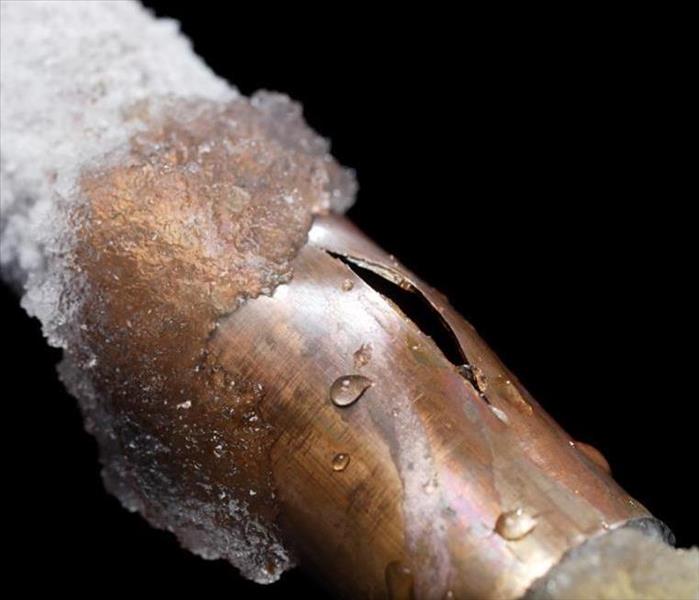 Frozen pipes can cause damage to your home or business.
Frozen pipes can cause damage to your home or business.
With the current freezing temperatures, the freezing rain and snow fall, we are receiving several calls and inquiries about how to thaw out frozen pipes.
Here are a few quick tips on how to prevent and get your pipes thawed out.
- Locate the frozen pipe – Begin your trace from the faucet that is not working and locate where the frozen pipe is.
- Open the Faucet - Before you begin attempting to thaw a frozen pipe, you will want to open the faucet that the pipe feeds water into. Make sure to open both the hot and cold handles. This will help to relieve pressure in the system and will allow the water to escape once you begin to thaw the pipe.
- Where to Begin the Thawing Process - You should always begin the thawing process near the faucet then work your way down to the blockage. This will help ensure that the melting ice and steam is able to escape through the open faucet. If you start the thawing process closer to the blockage, the melting ice could get stuck behind the blockage, creating more pressure in the pipe, and increasing the chances the pipe will burst.
- Thawing Exposed Pipes -If the frozen pipe is in an area you can easily access, you have several options for attempting to thaw the pipe. You should continue to apply the heat until the water escaping from the faucet returns to full strength. Here are four options for thawing an exposed pipe.
- Hair Dryer- One of the easiest ways to thaw a pipe is by using a hairdryer. Simply turn the dryer on and point the heat at the pipe, beginning with the portion closest to the faucet. As with any electrical product, take the proper precautions and avoid encountering water when operating the device.
- Heat Lamp or Portable Space Heater- Another method to thaw the pipe is to use a heat lamp or portable space heater. Position the device so that the heat can reach the frozen pipe. This indirect heat can help to quickly thaw a pipe. Again, make sure to comply with the safety measures and precautions on the device you are using and keep the device away from water. NOTE - This should be closely monitored so not to start a fire.
- Hot Towels- Another way to thaw a frozen pipe is to wrap towels that have been dipped in hot water around the pipe. This can help to slowly thaw the blockage.
- Electrical Heating Tape- A final option is to apply electrical heating tape directly to the pipe. This tape distributes heat throughout the pipe. You can purchase electrical heating tape that you plug in and unplug as needed or you can purchase heating tape that shuts off on its own.
- Things to Avoid - Never attempt to thaw a pipe using an open flame, such as a propane torch. This can not only damage the pipe, but it can also start a fire in your property.
- If the Pipe Bursts - If a frozen water pipe does burst, the first thing you should do is shut off the main water line into your property. This will prevent additional water from flowing and damaging your property. You should know where the shut-off valves are for each of your properties and for each unit. There are usually smaller shut-off valves located near sinks and toilets, but the main shut-off valve is often located near the water meter.
- If the Break is Outside of your House – If the water line break is outside of your house, contact your local water department.
- Call a Professional - Call a Professional- If you are unable to thaw the pipe, unable to locate the frozen pipe, do not feel comfortable thawing a pipe yourself or if a pipe bursts, or If you do have a problem with any plumbing issue, contact a licensed plumber or contact SERVPRO® of Mayes and Wagoner Counties and we can recommend a reputable plumbing service.
For more Tips and Tricks on how to prevent frozen pipes, check out more of our blogs at https://www.SERVPROmayesandwagonercounties.com/blog
SERVPRO® of Mayes and Wagoner Counties specializes in Fire and Water Cleanup and Restoration.
If you have any questions, call your SERVPRO® of Mayes and Wagoner Counites, 918-486-1055. 24/7 Emergency Response Always FREE Estimates for any job.
Tips to prevent Frozen Pipes
1/25/2021 (Permalink)
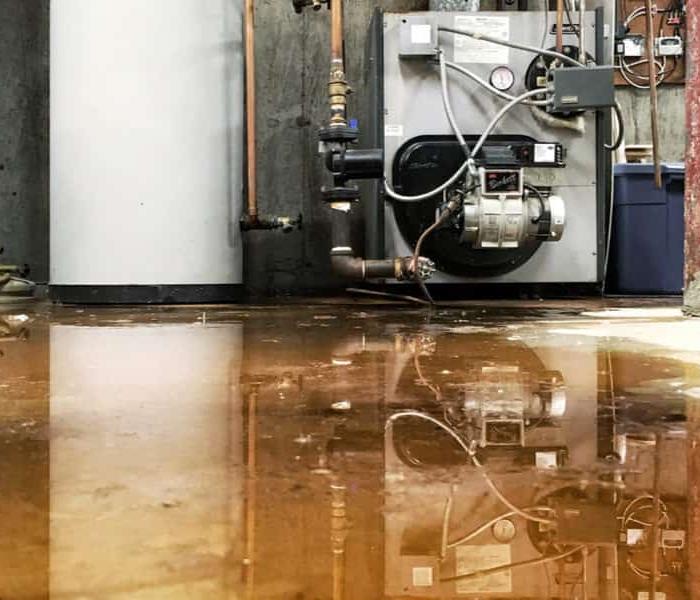 A frozen pipe from a recent freeze causes damage at a customer's home.
A frozen pipe from a recent freeze causes damage at a customer's home.
We haven’t had many below freezing days here in Eastern Oklahoma, but temperatures can get freezing cold and the consequences of freezing temperatures is unfortunately frozen water pipes.
There are many easy ways to prevent your pipes from freezing and here are a few measures you can take to ensure you are not dealing with water damage from busted pipes this winter.
Tips to Avoid Frozen Pipes
- Pay Attention to the Weather: Pipes typically freeze during long periods of freezing temperatures.
- Drain During the Fall: Now is the time to drain any outdoor water lines. Drain your outdoor water lines to swimming pools and sprinkler systems now so that there is no moisture left over that may cause them to freeze.
- Insulate: A great preventative measure to take is investing in sleeves for your pipes. Fashioning a sleeve style pipe insulator over your plumbing in unheated exterior walls, basements, crawl spaces, or garages is the best way to help these pipes remain above freezing temperatures.
- Proper insulation in your home helps too. Check to ensure that you have properly insulated all the rooms in your home. Now is the time to take note of any unusual drafts coming from doors or windows and alleviate the problem.
- Open Cabinets and Doors: Open the doors to your kitchen and bathroom cabinets. You might not realize how cold these spaces get when the doors are closed. Leaving these doors ajar allows warm air to circulate around your pipes and prevents them from freezing in cold weather.
- Let Your Faucet Drip: This step may seem counter-intuitive and even wasteful, but the energy expense of letting a little water drip from your faucet in extreme cold is nothing compared to a large repair bill for a pipe that burst because it froze over. By letting even, a trickle of water run through your pipe, it helps prevent the pipe from freezing.
- Keep Your Home Warm: You might want to cut corners on heating your home at night or if you take a vacation this winter, but it’s incredibly important to keep your home warm at all times. Keep your home at a relatively consistent temperature throughout the day and night.
- If you’re taking a trip for the holidays, leave your thermostat set for 55°F to avoid coming home to frozen plumbing. This is particularly important in our area with Grand Lake, Grand River, Spavinaw Lake, Hudson Lake and Fort Gibson Lake with Lake Homes. Take a day and inspect your lake home and ensure everything is where it needs to be.
If you do have a problem with any plumbing issue, contact a licensed plumber or contact SERVPRO® of Mayes and Wagoner Counties and we can recommend a reputable plumbing service.
SERVPRO® of Mayes and Wagoner Counties specializes in Fire and Water Cleanup and Restoration.
If you have any questions, call your SERVPRO® of Mayes and Wagoner Counites, 918-486-1055. 24/7 Emergency Response Always FREE Estimates for any job.
What to do with Water Damage
1/4/2021 (Permalink)
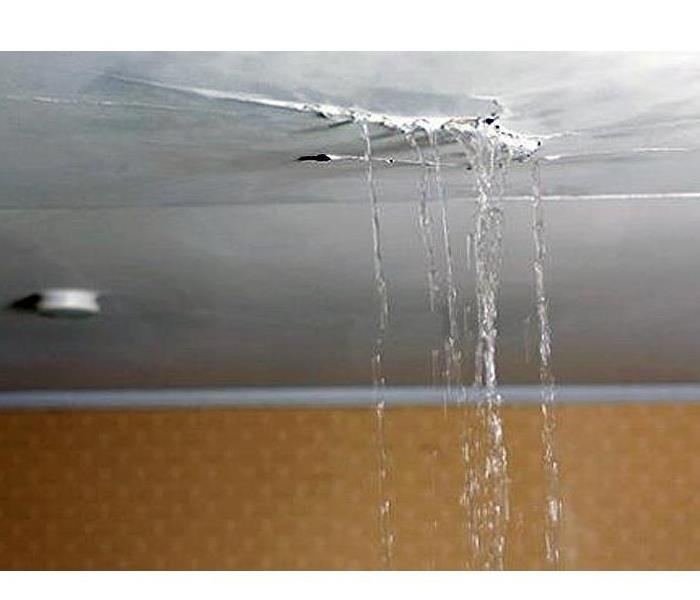 A customer's ceiling is leaking after the recent snow fall.
A customer's ceiling is leaking after the recent snow fall.
Water damage is two words that every home or business owner dreads hearing. And every water damage is different, each requiring a unique solution.
Your SERVPRO® of Mayes and Wagoner Counties team will inspect the damage to your property, then access what steps need to be taken, then create a plan of action.
Remember that SERVPRO® works will all insurance companies and is the preferred vendor for most insurance companies.
One of the most important parts of the process is determining where the water has come from. Whether the water has come from a leaking water line, a hot water tank, clogged toilets, broken water line, broken dishwasher hose, a washing machine, a leaky roof, foundation cracks, a flood or from recent snow and or ice. Finding the cause and making sure that the leak is fixed is the first of many steps that need to be taken.
The Damage
If left unresolved water damage can cost the home or business owner thousands of dollars’ worth of damage.
- Even minor water leaks can lead to larger issues later if not resolved.
- Water can:
- Damage flooring, particularly wood and laminate flooring.
- Walls (sheetrock, drywall panels).
- Cause rotting wood (cabinets).
- Damage household appliances.
- Ruin carpet and padding.
- Damage furniture.
- Cause rusting of metal.
- Lead to mold growth.
- Mold growth can occur very quickly and lead to even more issues, including health related if not treated properly by a trained professional such as our SERVPRO® team.
The Recovery
It is important to get our SERVPRO® team to the water loss as soon as possible to get the water removed swiftly.
- Our technicians use specialized equipment to target the water and use moisture sensing equipment to detect any wetness hiding where we cannot see.
- We will remove all the moisture from your property with air movers and dehumidifiers. Sometimes this may take a few days to complete this process.
- We will remove any damaged property such as carpet, cabinets, and appliances from the affected areas.
- We will also remove with care, any belongings such as furniture, clothing, and personal items that can be restored. We can clean and sanitize many of your restorable items.
- The restoration process could include major reconstruction, such as rebuilding. SERVPRO® can rebuild everything, from a room to a whole house or business.
SERVPRO® of Mayes and Wagoner Counties specializes in Fire and Water Cleanup and Restoration.
If you have any questions, call your SERVPRO® of Mayes and Wagoner Counites, 918-486-1055. 24/7 Emergency Response. And always FREE Estimates for any job.
Water Heaters 101
12/11/2020 (Permalink)
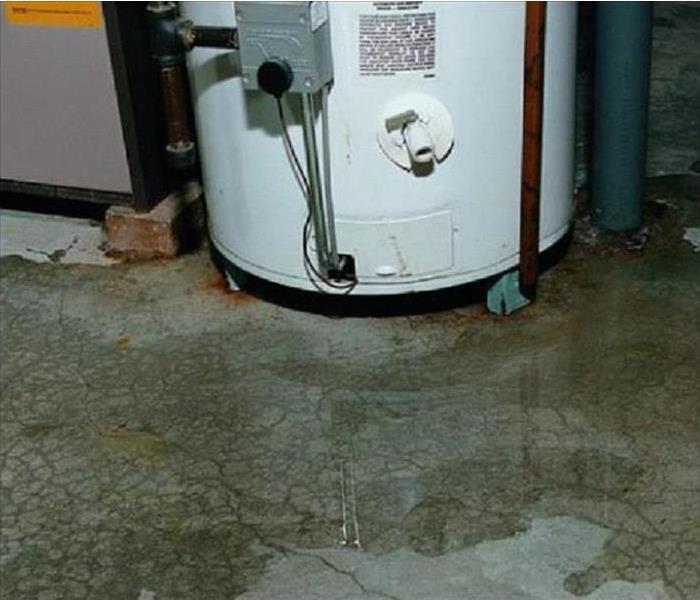 Leaking Hot Water Tank
Leaking Hot Water Tank
Your hot water heater or tank is one of the most vital parts of your home or business. Here are a few tips on what to look for if your hot water heater fails you.
As homeowners, we do not like thinking about things in our homes breaking down. But the reality is that eventually, everything in our home will need to be replaced. There will come a time when things start to not work properly and reach the end of their life. However, regular inspection and maintenance of your home and business systems can help to prevent costly expenses down the road.
One of the most telltale signs you need a new electric hot water heater is that the water will be colder than usual. This may not always mean that the water is necessarily cold. You may notice that the water does not get past a lukewarm temperature. The water may also get colder faster. For instance, you may usually take a fifteen-minute hot shower and have no issues with the temperature of the water changing. Then, you may only be able to take a five-minute shower because the temperature of the water just will not stay warm. This could be true for the faucets or the shower.
The first thing you want to do is check to make sure you do not have any leaks coming from your water heater. If you do find a leak, locate the water shut off to the tank and turn it off. A small leak typically does not affect performance; however, it could lead to other issues such as mold or water damage. One of the most common problems with an electric water heater with a tank, is that the bottom of the tank can rust and break apart. Gallons of water will spill out without warning. Shut off the water supply to the tank and call your local SERVPRO team.
If you don’t have any leaks it could be electrical. There are several key components to your water heater that can fail that will keep you from having hot water at the tap. There are three major parts that can fail that will keep the water from getting hot: the upper element, the lower element, and the thermostat. The elements are metal bars that heat up from the electricity that is fed to the water heater and the thermostat keeps the water temperature heated accurately.
Before you get near your water heater be sure to shut off the electricity and water supply to it. Turn off the power at the breaker box to ensure there is no electricity running through the equipment before any service or trouble shooting is done.
Remember if you have any questions or need water extraction or mitigation, call your SERVPRO of Mayes and Wagoner Counites, 918-486-1055.
Untreated Water Damage Leads to Mold Growth
4/30/2020 (Permalink)
When water damage is left untreated, mold growth quickly occurs. Contact SERVPRO of Mayes & Wagoner Counties at the first sign of water damage.
If you have ever been curious about where a certain odor was coming from and almost went crazy looking for the source, there is a chance it could have been caused by water damage. But how does water damage cause such foul smells, and what can you do about them? SERVPRO of Mayes & Wagoner Counties provides restoration services and has experience in dealing with this kind of issue.
Although it often starts out as just a nuisance, water damage can worsen over time. Seeping water can lead to the growth of mold and mildew, which is when foul odors start to emerge. Water triggers mold to release spores, creating a sickening stench. Odors can also be a result of other contaminants. For instance, when a sewer backs up, the resulting smell comes from the sewage that is inside your home.
So, what can you do about it? Well, this is one mess you definitely should not try to clean up yourself: Water damage always calls for a professional touch. Additionally, if there is any form of sewage present, you will need professional sewage cleanup services to remove all the hazardous and toxic materials. The same is true for mold cleanup. And remember: It is important to call an expert right away. Whether you just noticed a leak or your home recently sustained a flood, now is the time to contact a specialist. If you wait too long, the damage could become more expensive to repair and may even harm your health.
If you have water damage and need a crew that can handle large cleanups with ease, get in touch with SERVPRO of Mayes & Wagoner Counties. Their friendly staff can help with all types of damage done to your home. To find out more about the services they offer, call (918)486-1055.
Our New Year's Resolution
1/13/2020 (Permalink)
3, 2, 1.... NO!!!!
New Years is always full of fun and exciting times. The best part of New Years is setting your “New Year's Resolution”. Here at SERVPRO of Mayes & Wagoner Counties, we have a resolution of our own. Our resolution is to educate more people about how we do what we do. So, here is a countdown of some of the things that make SERVPRO your go to for any type or size of water loss.
5: We provide 24-hour service every day of the year, including holidays, so we are always prepared for when you need us the most.
4: Our team is highly trained in water mitigation.
3: For every job we get called into, we have a policy. The 1-4-8 Policy. Our goal is within one hour, a representative will make initial contact with you and set up a time to be there. We have 4 hours to be on site at your disaster- big or small. We have 8 hours to brief the team and get started on getting your home or business back "Like it never even happened."
2: Our advanced equipment helps to detect hidden moisture, extract the standing water quickly, and thoroughly clean and dry your home and belongings.
1: A trusted leader in the Restoration Industry with over 1,700 Franchises.
Here at SERVPRO of Mayes & Wagoner Counties, we pride ourselves on being the best at what we do. From the moment we get the call, our objective is to give our customer the best results. We provide a nice and friendly experience to go along with the hard work that we put into each and every job. Make it your New Year’s Resolution to use SERVPRO of Mayes & Wagoner Counties in your time of need and we will do our best not to disappoint.






 24/7 Emergency Service
24/7 Emergency Service









